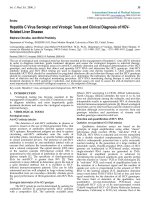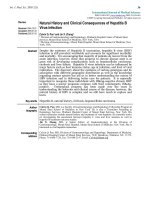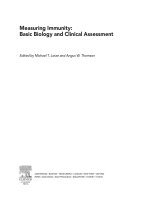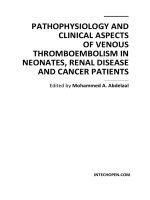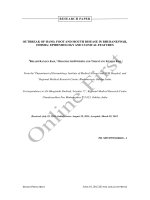NEUROIMAGING – COGNITIVE AND CLINICAL NEUROSCIENCE potx
Bạn đang xem bản rút gọn của tài liệu. Xem và tải ngay bản đầy đủ của tài liệu tại đây (19.51 MB, 478 trang )
NEUROIMAGING –
COGNITIVE AND CLINICAL
NEUROSCIENCE
Edited by Peter Bright
Neuroimaging – Cognitive and Clinical Neuroscience
Edited by Peter Bright
Published by InTech
Janeza Trdine 9, 51000 Rijeka, Croatia
Copyright © 2012 InTech
All chapters are Open Access distributed under the Creative Commons Attribution 3.0
license, which allows users to download, copy and build upon published articles even for
commercial purposes, as long as the author and publisher are properly credited, which
ensures maximum dissemination and a wider impact of our publications. After this work
has been published by InTech, authors have the right to republish it, in whole or part, in
any publication of which they are the author, and to make other personal use of the
work. Any republication, referencing or personal use of the work must explicitly identify
the original source.
As for readers, this license allows users to download, copy and build upon published
chapters even for commercial purposes, as long as the author and publisher are properly
credited, which ensures maximum dissemination and a wider impact of our publications.
Notice
Statements and opinions expressed in the chapters are these of the individual contributors
and not necessarily those of the editors or publisher. No responsibility is accepted for the
accuracy of information contained in the published chapters. The publisher assumes no
responsibility for any damage or injury to persons or property arising out of the use of any
materials, instructions, methods or ideas contained in the book.
Publishing Process Manager Sandra Bakic
Technical Editor Teodora Smiljanic
Cover Designer InTech Design Team
First published May, 2012
Printed in Croatia
A free online edition of this book is available at www.intechopen.com
Additional hard copies can be obtained from
Neuroimaging – Cognitive and Clinical Neuroscience, Edited by Peter Bright
p. cm.
ISBN 978-953-51-0606-7
Contents
Preface IX
Chapter 1 Cytoarchitectonics of the Human Cerebral Cortex:
The 1926 Presentation by Georg N. Koskinas
(1885–1975) to the Athens Medical Society 1
Lazaros C. Triarhou
Chapter 2 Images of the Cognitive Brain Across Age and Culture 17
Joshua Goh and Chih-Mao Huang
Chapter 3 Neuroimaging of Single Cases:
Benefits and Pitfalls 47
James Danckert and Seyed M. Mirsattarri
Chapter 4 Functional and Structural Magnetic Resonance
Imaging of Human Language:
A Review 69
Manuel Martín-Loeches and Pilar Casado
Chapter 5 Neuro-Anatomical Overlap Between Language and
Memory Functions in the Human Brain 95
Satoru Yokoyama
Chapter 6 Neuronal Networks Observed with Resting State
Functional Magnetic Resonance Imaging in
Clinical Populations 109
Gioacchino Tedeschi and Fabrizio Esposito
Chapter 7 Resting State Blood Flow and Glucose Metabolism in
Psychiatric Disorders 129
Nobuhisa Kanahara, Eiji Shimizu,
Yoshimoto Sekine and Masaomi Iyo
Chapter 8 The Memory, Cognitive and Psychological Functions of Sleep:
Update from Electroencephalographic and
Neuroimaging Studies 155
Roumen Kirov and Serge Brand
VI Contents
Chapter 9 Neuroimaging and Outcome Assessment in
Vegetative and Minimally Conscious State 181
Silvia Marino, Rosella Ciurleo, Annalisa Baglieri,
Francesco Corallo, Rosaria De Luca, Simona De Salvo,
Silvia Guerrera, Francesca Timpano,
Placido Bramanti and Nicola De Stefano
Chapter 10 Functional and Structural MRI Studies on Impulsiveness:
Attention-Deficit/Hyperactive Disorder and
Borderline Personality Disorders 205
Trevor Archer and Peter Bright
Chapter 11 MRI Techniques to Evaluate Exercise Impact on
the Aging Human Brain 229
Bonita L. Marks and Laurence M. Katz
Chapter 12 Human Oscillatory EEG Activities Representing
Working Memory Capacity 249
Masahiro Kawasaki
Chapter 13 Neuroimaging Data in Bipolar Disorder:
An Updated View 263
Bernardo Dell’Osso, Cristina Dobrea,
Maria Carlotta Palazzo, Laura Cremaschi,
Chiara Arici, Beatrice Benatti and A. Carlo Altamura
Chapter 14 Reinforcement Learning, High-Level Cognition, and
the Human Brain 283
Massimo Silvetti and Tom Verguts
Chapter 15 What Does Cerebral Oxygenation Tell Us
About Central Motor Output? 297
Nicolas Bourdillon and Stéphane Perrey
Chapter 16 Intermanual and Intermodal Transfer in Human Newborns:
Neonatal Behavioral Evidence and
Neurocognitive Approach 319
Arlette Streri and Edouard Gentaz
Chapter 17 Somatosensory Stimulation in Functional Neuroimaging:
A Review 333
S.M. Golaszewski, M. Seidl, M. Christova, E. Gallasch, A.B. Kunz,
R. Nardone, E. Trinka and F. Gerstenbrand
Chapter 18 Neuroimaging Studies in Carbon Monoxide
Intoxication 353
Ya-Ting Chang, Wen-Neng Chang, Shu-Hua Huang,
Chun-Chung Lui, Chen-Chang Lee,
Nai-Ching Chen and Chiung-Chih Chang
Contents VII
Chapter 19 Graphical Models of Functional MRI Data for
Assessing Brain Connectivity 375
Junning Li, Z. JaneWang and Martin J. McKeown
Chapter 20 Event-Related Potential Studies of Cognitive and
Social Neuroscience 397
Agustin Ibanez, Phil Baker and Alvaro Moya
Chapter 21 Neuroimaging Outcomes of Brain Training Trials 417
Chao Suo and Michael J. Valenzuela
Chapter 22 EEG-Biofeedback as a Tool to Modulate Arousal:
Trends and Perspectives for
Treatment of ADHD and Insomnia 431
B. Alexander Diaz, Lizeth H. Sloot,
Huibert D. Mansvelder and Klaus Linkenkaer-Hansen
Chapter 23 Deconstructing Central Pain with Psychophysical and
Neuroimaging Studies 451
J.J. Cheng, D.S. Veldhuijzen, J.D. Greenspan and F.A. Lenz
Preface
The rate of technological progress is encouraging increasingly sophisticated lines of
enquiry in cognitive neuroscience and shows no sign of slowing down in the
foreseeable future. Nevertheless, it is unlikely that even the strongest advocates of the
cognitive neuroscience approach would maintain that advances in cognitive theory
have kept in step with methods-based developments. There are several candidate
reasons for the failure of neuroimaging studies to convincingly resolve many of the
most important theoretical debates in the literature. For example, a significant
proportion of published functional magnetic resonance imaging (fMRI) studies are not
well grounded in cognitive theory, and this represents a step away from the traditional
approach in experimental psychology of methodically and systematically building on
(or chipping away at) existing theoretical models using tried and tested methods.
Unless the experimental study design is set up within a clearly defined theoretical
framework, any inferences that are drawn are unlikely to be accepted as anything
other than speculative. A second, more fundamental issue is whether neuroimaging
data alone can address how cognitive functions operate (far more interesting to the
cognitive scientist than establishing the neuroanatomical coordinates of a given
function – the where question).
The classic neuropsychological tradition of comparing neurologically impaired and
healthy populations shares some of the same challenges associated with neuroimaging
research (such as incorporation of individual differences in brain structure and
function, attribution of specific vs general functions to a given brain region, and the
questionable assumption that the shared components operating in two tasks under
comparison recruit the same neural architecture. However, a further disadvantage of
functional neuroimaging relative to the neuropsychological approach is that it is a
correlational method for inferring regional brain involvement in a given task – and
interpretation of signal should always reflect this fact. Spatial resolution and
sensitivity is improving with the commercial availability of ultra-high field human
scanners, but a single voxel (the smallest unit of measurement) still corresponds to
many thousands of individual neurons. Haemodynamic response to input is slow (in
the order of seconds) and the relationship between this function and neural activity
remains incompletely understood. Furthermore, choice of image preprocessing
parameters can appear somewhat arbitrary and an obvious rationale for selection of
statistical thresholds, correction for multiple corrections, etc. at the analysis stage can
X Preface
likewise be lacking in some studies. Therefore, to advance our knowledge about the
neural bases of cognition, rigorous methodological control, well-developed theory
with testable predictions, and inferences drawn on the basis of a range of methods is
likely to be required.
Triarhou (Chapter 1) provides a translation of Georg Koskinas’ 1926 presentation to
the Athens Medical Society in which the neuropsychiatrist described 107
cytoarchitectonically defined cortical areas (plus 60 “transition” areas) in the human
brain. In comparison to Brodmann’s (1909) universally recognised system (in which 44
cortical areas are defined), the von Economo and Koskinas system (published as an
atlas and textbook in 1925) provided a fourfold increase in cortical specification. The
author provides a compelling argument for more widespread adoption of von
Economo and Koskinas’ detailed criteria (commonly used in clinical neuroscience) in
neuroimaging studies of human cognition.
Heterogeneity in brain structure and function across individuals is an important issue
in neuroimaging research. Although attempts are made to manage such differences
during stages of preprocessing and statistical analyses of datasets (as well as during
the participant selection process), there can be a tendency to neglect the importance of
individual differences due to the importance in the literature of identifying
commonalities in the functioning of our brains. For example, it is quite common in
fMRI studies to find participants who have relatively “silent” brains relative to others
undertaking the same cognitive task. Age is a well recognised factor affecting brain
structure and function, but the importance of cultural differences is relatively poorly
understood. Goh and Huang (Chapter 2) present neuroimaging findings associated
with age and cultural experience and also consider their interaction. Interestingly,
research appears to suggest that culture-specific functional effects present in early
adulthood are robust and remain in place despite subsequent age-related
neurobiological change. Such observations also suggest that ageing effects in the brain
may, in part, be contingent upon the nature of external experiences – raising clinical
implications for modulating or offsetting neurocognitive changes associated with
increasing age.
Danckert and Mirsattari (Chapter 3) consider the viability of fMRI studies of single
neurological cases for furthering our understanding of brain-behaviour
relationships. With careful attention to methodological issues, the authors present a
strong argument for the single case approach (for both clinical and cognitive
neuroscience purposes) in which comprehensive neuropsychological assessment
and fMRI are employed and the results interpreted in the context of large-scale
normative structural and functional MRI data. Chapter 4 (Martín-Loeches & Casado)
provides a useful review of recent research on the neural correlates of human
language and Chapter 5 (Yokoyama) considers whether (and the extent to which)
brain regions responsible for core language processes can be dissociated from those
responsible for more general cognitive processes associated with working memory
and central executive function.
Preface XI
Tedeschi and Esposito (Chapter 6) present an excellent consideration of the utility of
measuring resting state networks (RSNs) in clinical populations using fMRI. Some
authors have questioned whether systematic neuroimaging analysis of the resting
state represents an appropriate context for advancing cognitive theory.
Nevertheless, this review presents a highly compelling argument for studying RSNs
(particularly when combined with MRI tractography) in order to enhance
understanding of pathological mechanisms in a range of neurological conditions.
Kanahara et al. (Chapter 7) focus their comprehensive review on single-photon
emission computed tomography (SPECT) and photon emission tomography (PET)
studies of resting state blood flow and metabolism in a range of psychiatric
conditions including schizophrenia, major depressive disorder, bipolar disorder and
obsessive-compulsive disorder.
Sleep deprivation is associated with a wide range of neurocognitive effects, but
attention and other aspects of executive function appear particularly vulnerable. Kirov
and Brand (Chapter 8) review evidence for the role of sleep in the regulation of
cognitive functions, with particular focus on neuroimaging investigations. The
distinction between vegetative state (VS) and minimally conscious state (MCS) is
clearly expressed in the clinical literature. The former refers to a state of “wakeful
unawareness” in which patients are awake, can open their eyes and produce basic
orienting responses, but have a total loss of conscious awareness. MCS differs to the
extent that patients with this diagnosis are able to produce cognitively mediated
behavioural responses. From a clinical perspective however, the distinction can be
very difficult and a number of recent neuroimaging studies have provided indirect
evidence that some VS patients have been able to communicate answers to orally
presented questions. This rather disturbing finding that such patients may be more
aware than the clinicians (or family members) may realise is of profound clinical
importance given the very different prognosis and treatments indicated in the two
conditions. Marino et al. (Chapter 9) review the role of neuroimaging in improving our
understanding of coma, VS and MCS while recognising the continuing importance of
comprehensive standardised clinical assessment.
Impulsive behavior is a major component of several neuropsychiatric disorders
including schizophrenia, attention-deficit/hyperactivity disorder (ADHD), substance
abuse, bipolar disorder, and borderline and antisocial personality disorders. The
temporal, motor and reward related aspects of impulsiveness and decision-making are
exemplified by the impulsive behaviors typically evident in ADHD and borderline
personality disorder (BPD), with or without comorbidity. Archer and Bright (Chapter
10) consider the role of structural and functional neuroimaging for furthering our
understanding of the cause and development of impulsivity in these conditions.
Marks and Katz (Chapter 11) carefully evaluate the potential role of MRI for
establishing the nature of the relationship between exercise and the integrity (both
physiological and cognitive) of the brain. The question of whether (and the extent to
which) exercise can offset age-related cognitive decline is one which has attracted a
XII Preface
wealth of dubious “research findings” reported in the popular press, and this well
argued and balanced review is a very welcome addition to the literature.
Recent research suggests that synchronization of oscillatory phases across brain
regions (measured by EEG and MEG) may provide the basis for goal-directed
attentional allocation and working memory functions. Kawasaki (Chapter 12) presents
two EEG investigations implicating the role of frontal theta oscillations in conditions
requiring active manipulation of the contents of working memory and parietal alpha
oscillations in simple maintenance of working memory contents. These findings
complement recent claims in the literature about the hierarchical organization (and
dissociation) of cognitive control mechanisms in the human brain.
It is now recognized that bipolar disorder (BD) is associated with reductions in grey
matter volume, particularly in right prefrontal, insular and anterior temporal regions.
Nevertheless, in their review of neuroimaging findings, Dell’Osso et al. (Chapter 13)
reveal inconsistencies in the literature (particularly on MRI). Most neuroimaging
studies of structural changes in BP have small sample sizes and may therefore lack the
power to detect subtle effects relative to appropriately matched controls. While some
very recent meta-analyses have sought to address this problem, the current chapter
serves a useful reminder that neuropsychiatric conditions typically encompass
heterogeneity in symptom severity and diversity and in the ratio of organic to
psychosocial factors driving their expression.
Silvetti and Verguts (Chapter 14) consider the utility of biologically driven
reinforcement learning models for clarifying our understanding of attention and
executive functions. The literature highlights the importance of functional
relationships between anterior cingulate cortex and basal ganglia in cognitive control,
but arguably the framework in which such relationships are investigated is overly
constrained. The authors suggest that neural Darwinism (which, in this context,
predicts that a sensory state will be considered valuable only if it subsequently leads to
another valuable state) provides a broader and more appropriate context for
explaining adaptive behaviour.
Principles and applications of functional near-infrared spectroscopy (fNIRS) are
presented by Bourdillon and Perrey (Chapter 15), with particular focus on the
measurement of cerebral oxygenation during motor performance. The size and
portability of fNIRS devices provides opportunities for enhancing ecological validity
of research investigations (in comparison to the restrictive conditions of fMRI), but
strength of inferences which can be drawn are limited by a range of potential
confounds and the lack of a standardised approach to data analysis. Nevertheless, the
authors convincingly demonstrate the utility of this approach, particularly for the
mapping of exercise-related brain functions.
Streri and Gentaz (Chapter 16) provide a fascinating review of intermanual and
intermodal transfer in newborns. In contrast to the long held view that newborns
Preface XIII
primarily display involuntary reflexes and reactions, evidence (based on habituation-
dishabituation procedures) indicates that the haptic system is able to detect
regularities and irregularities in the shape or texture of different objects – and that the
tactile knowledge newborns accrue about an object held in one hand is transferred to
the other hand despite the immaturity of the corpus callosum. Interestingly, cross-
modal transfer is not always bidirectional. For example, newborns appear unable to
apply haptic perception to recognise a visually presented shape but they can visually
recognise the shape of an object they have held in their hand. In contrast, intermodal
transfer for texture does appear to be bi-directional between touch and vision. The
authors review behavioural studies of infants and neuroimaging data in adults in
order to address the interdependencies of the visual and haptic systems from a
predominantly developmental perspective.
Golaszewski et al. (Chapter 17) present a detailed overview of the somatosensory
system, with particular focus on functional neuroimaging investigations. Principles
and methods of somatosensory stimulation are discussed including practical
considerations, clinical applications and safety issues. Chang et al. (Chapter 18)
describe the process of oxidative stress caused by carbon monoxide intoxication and
present nicely illustrated structural and functional neuroimaging features.
Li et al. (Chapter 19) provide a very clearly written and beautifully illustrated
introduction to the measurement of effective connectivity with fMRI, in which the
functional influence of one or more spatially distributed brain areas on another brain
area is modelled. The authors are careful to emphasise the importance of a rigorous
theoretical background, tight error control, intuitive interpretation and
acknowledgement of likely commonality as well as diversity in connectivity within
and across clinical and healthy populations.
Until very recently, it is probably fair to suggest that the status of EEG as a tool for
exploring human cognition had diminished, due in no small part to the staggering
increase in fMRI based research published in leading journals in cognitive
neuroscience and related fields over the past 10-15 years. However, such a diminution
is unwarranted, because both approaches continue to offer outstanding and
complementary opportunities for understanding the neural bases of cognition (while
also presenting significant methodological and interpretative challenges). Many of the
leading journals are now encouraging manuscript submissions incorporating multiple
methods, and the simultaneous employment of EEG and fMRI has had important
repercussions both for progressing cognitive theory and promoting advances in
method. Ibanez et al. (Chapter 20) describe the role of event related potentials (ERPs),
measured with EEG, for understanding the temporal dynamics of sensory, perceptual
and cognitive activity and consider the importance of this method to the study of
social neuroscience.
Claims that “cognitive training” has a positive impact on structural and/or functional
integrity of the brain are often raised in the media but are typically unsupported by
XIV Preface
empirical evidence (this, of course has not prevented unscrupulous companies
marketing “brain training” exercises and devices to the unwary customer). In
particular, where specific studies have been reported in the media, they typically fail to
offer evidence that results generalise beyond a straightforward practice effect on the
employed tasks. Suo and Valenzuela (Chapter 21) provide a welcome review of
neuroimaging outcomes associated with brain training trials by selecting only those
studies published in peer reviewed publications which meet established criteria for
scientific rigour. Nevertheless, readers may remain sceptical about the likelihood that
the reported effects (often based on quite limited training) reflect general and robust
non-specific improvements in cognitive performance (rather than simply reflecting
changes associated with task-specific practice), and this review effectively
communicates the heterogeneity in methods and outcomes across studies. The authors
provide a number of suggestions for improving the quality and standardisation of
research designs, and the strength of the inferences that can be drawn.
EEG-biofeedback (EBF) is an approach used to encourage participants to modulate
CNS arousal by responding to real-time representation or feedback about their own
brain activity. Diaz et al. (Chapter 22) describe the efficacy of this method for treating
attention deficit hyperactivity disorder (ADHD) and insomnia. While acknowledging
considerable theoretical and methodological issues, not least concerning the validity of
the method as an effective form of therapy, the authors outline a number of sensible
procedural guidelines that are now being followed (particularly the use of
confirmatory evidence derived from other methods). Well controlled studies are
appearing in the literature, and these tend to suggest promising avenues for EBF
therapy in the treatment of some clinical disorders affecting CNS arousal. Central pain
is a debilitating condition resulting from lesion or disease involving the central
somatosensory system. In central post-stroke pain (CPSP), which occurs in
approximately 10% of stroke patients, thalamic nuclei are most frequently implicated
in the mechanism of central pain. On the basis of their review of psychophysical and
neuroimaging findings in CPSP, Cheng et al. (Chapter 23) suggest a more complex
distributed network of cortical regions is involved in the mechanism of central pain.
Dr. Peter Bright
Anglia Ruskin University,
Cambridge,
UK
1
Cytoarchitectonics of the Human
Cerebral Cortex: The 1926 Presentation
by Georg N. Koskinas (1885–1975)
to the Athens Medical Society
Lazaros C. Triarhou
University of Macedonia, Thessaloniki
Greece
1. Introduction
The Greek neurologist-psychiatrist Georg N. Koskinas (1885–1975) is better known for his
collaboration with Constantin von Economo (1876–1931) on the cytoarchitectonic study of
the human cerebral cortex (von Economo & Koskinas, 1925, 2008). Koskinas seems to have
been one of those classically unrecognised and unrewarded figures of science (Jones, 2008,
2010). Such an injustice has been remedied in part in recent years (Triarhou, 2005, 2006). The
Fig. 1. The Vienna General Hospital on the left, where Koskinas worked between 1916 and
1927 under the supervision of Julius Wagner von Jauregg (1857–1940) and Ernst Sträussler
(1872–1959) (author’s archive). The 1926 roster of the Vienna Society for Psychiatry and
Neurology on the right, showing Koskinas as a regular member (Hartmann et al., 1926)
Neuroimaging – Cognitive and Clinical Neuroscience
2
year 2010 has marked the 125th birthday anniversary of Koskinas (1 December 1885) and the
centennial of his graduation from the University of Athens (M.D., 1910).
As soon as the Atlas and Textbook of Cytoarchitectonics were published in 1925, Koskinas
briefly returned to Greece and donated a set to the Athens Medical Society. On that
occasion, he delivered a keynote address, which summarises the main points of his
research with von Economo. That address (Koskinas, 1926) forms the main focus of this
paper. There are only two other presentations known to have been made by Koskinas: one
with von Economo at the Society for Psychiatry and Neurology in Vienna in February
1923 (von Economo & Koskinas, 1923), presenting an initial summary of cytoarchitectonic
findings on the granularity of sensory cortical areas especially in layers II and IV; and the
other with Sträussler at the 88th Meeting of the German Natural Scientists and Physicians
in Innsbruck in September 1924 (Sträussler & Koskinas, 1925), reporting histopathological
findings on the experimental malaria treatment of patients with general paralysis from
neurosyphilis.
2. The 1926 presentation by Koskinas
The following is an exact English translation of the Proceedings of the Athens Medical
Society, Session of Saturday, 23 January 1926, rendered from the original Greek text
(Koskinas, 1926) by the author of the present chapter.
2.1 Introductory comment by Constantin Mermingas, presiding
”I am in the gratifying position of announcing an exceptional donation, made to the Society
by the colleague Dr. G. Koskinas, sojourning in Athens; having temporarily come from
Vienna, he brought with him a copy, as voluminous as you see, but also as valuable, of the
truly monumental compilation, produced by the two Hellenic scientists in Vienna, C.
Economo and G. Koskinas, who is among us today. It involves the book—text volume and
atlas—Cytoarchitektonik der Hirnrinde des erwachsenen Menschen, about the value of which we
had learnt from reviews published in foreign journals, but also convinced directly. Dr.
Koskinas deserves our warm thanks, as well as our gratitude, for being willing to deliver a
synopsis of that original scientific research and achievement.“
2.2 Main lecture by Georg N. Koskinas, keynote speaker
“Thanks to the ardour of the honourable President of the Society, Professor Dr.
Mermingas, who is meritoriously making every attempt to highlight the Society as a
centre of noble emulation in scientific research and the promotion of science and at the
encouragement of whom I have the honour of being a guest at the Society today.
Enchanted by that, I owe acknowledgments because you are offering me the opportunity
to briefly occupy you in person about the work published by Professor von Economo and
myself in German, and deposited to the chair of the Society, “The Cytoarchitectonics of
the Human Cerebral Cortex“ (Die Cytoarchitektonik der Hirnrinde des erwachsenen
Menschen). An attempt on my behalf to analyse that work requires much time and many
auxiliary media which, simply hither passing through, I lack. That is why I wish to
confine myself, such that I very briefly cover the following simply and to the extent
possible.
Cytoarchitectonics of the Human Cerebral Cortex:
The 1926 Presentation by Georg N. Koskinas (1885–1975) to the Athens Medical Society
3
Fig. 2. Previously unpublished photographs of Koskinas and family members. The left
photograph, taken in Vienna around 1926, shows Koskinas (first from the right) with his
wife Stefanie, their daughter, his sister Paraskevi and her husband. The right photograph
shows Koskinas (second from the right) in the Peloponnese in the 1940s—the bridge of the
Eurotas River appears in the background—with his wife and daughter (left), and the
children of his sister Irene and their father (photos courtesy of Rena Kostopoulou)
2.2.1 Incentives and aim
The incomplete and largely imperfect knowledge of the histological structure of the brain
constituted the main reason that led us to its detailed architectonic research, and its ultimate
goal was the localisation, to the extent possible, of the various cerebral functions and the
pathological changes in mental disorders, as well as the interpretation of numerous
problems, such as individual mental attributes, i.e. the talent in mathematics, music,
rhetoric, etc.
2.2.2 Methods
At the outset of our studies we came across various obstacles and difficulties deriving on
one hand from the very structure of the brain and on the other from the deficiency of the
hitherto available research means. That is why we were obliged to modify numerous of the
known means, to incise absolutely new paths, taking advantage of any possible means
towards a precise, reliable and indelible rendition of nature. We modelled an entire system
of new methods of brain research from the autopsy to the definitive photographic
documentation of the preparations. Thus, we were able to not only solve many of the
problems, but also, and above all, to provide to anyone interested various topics for
investigation, as well as the manner for exploring them.
Allow me to mention some of the employed research means.
Sectioning method. Instead of the hitherto used method of sectioning the whole brain serially
perpendicular to its fronto-occipital axis (Fig. 5), whereby gyri are rarely sectioned
perpendicularly, we effected the sections always perpendicular to the surface of each gyrus
and in directions corresponding to their convoluted pattern (Fig. 6). We arrived at that act
Neuroimaging – Cognitive and Clinical Neuroscience
4
by the idea that, in order to compare various parts of the brain cytoarchitectonically,
sections must be oriented perpendicularly to the surface of the gyri, insofar as only then is
provided precisely the breadth of both the overall cerebral cortex and of each cortical layer.
Fig. 3. The Proceedings of the Athens Medical Society for the Session of 23 January 1926
Staining method. The staining of the preparations was perfected by us such that a uniform
tone was achieved not only of a single section, but of all the countless series of sections into
which each brain was cut for study. And that was absolutely mandatory, on one hand in
order to define the gradual differences of the histological elements of the neighbouring areas
of the cerebral cortex, and on the other hand to achieve a consistent photographic
representation.
Specimen depiction method. The hitherto occasional histological investigations of the brain
depicted things schematically and therefore subjectively. Instead of such a schematic
depiction, aiming at a precise representation of the preparations with all the relationships of
the countless and polymorphous cells, we used photography. Photographic documentation
constitutes the most truthful testimony of the exact depiction of nature, providing truly
objective images of things as they bear in natural form, size and arrangement (Fig. 7). But to
succeed in the photographic method it became necessary to turn to the study of branches
foreign to medicine, such as advanced optics and photochemistry. We took advantage of
both of these as much as we could. Lenses, light beams, filters, photographic plates and
finally the photographic paper itself were all adopted towards the accomplishment of the
intended goal of the most perfect, i.e. the photographic, depiction.
Cytoarchitectonics of the Human Cerebral Cortex:
The 1926 Presentation by Georg N. Koskinas (1885–1975) to the Athens Medical Society
5
Fig. 4. Constantin Mermingas (1874–1942), Professor of Surgery at the University of Athens
and President of the Athens Medical Society (left), Georg N. Koskinas (1885–1975) in the
centre, and Spyridon Dontas (1878–1958), Professor of Physiology and Pharmacology at the
University of Athens and President of the Academy of Athens (right). © 1957 Helios
Encyclopaedical Lexicon (signatures from the author’s archive)
2.2.3 Accomplished and anticipated results
Through our work an extremely precise and detailed description was achieved of the
normal histological structure of the cerebral cortex as it is depicted in the photographic
plates and explained in the text. Our photographic plates in the atlas, as such, constitute an
ageless, imprescriptible opus, the basis and the control of any future research on the cerebral
cortex. Whatever in such research is in agreement with the plates, must be considered as
normal, and whatever diverges constitutes a pathological condition. From that precise
knowledge of the architectonic structure of the cerebral cortex, which we achieved, it is
allowable to anticipate the solution of numerous and different questions and issues of
utmost importance; from their endless number I suffice in mentioning e.g. the following.
a. The problem of problems, i.e. the problem of the psyche. When, as anatomists and physiologists,
we speak of the psyche, we do not refer to it as a metaphysical being that finds itself a
priori outside any anatomical and physiological weight, but as a moral, mental, active and
historical personality which interacts with others and influences ourselves.
b. The problem of individual mental attributes, i.e. intellectual talents, such as rhetoric, music,
mathematics, delinquency and the variations in the mental development of human
phyla on the earth. By comparing e.g. the centres of music in individuals who
genetically present a total lack of music perception to individuals who possess an
evolved musical talent we may exactly pinpoint differences in such music centres.
Neuroimaging – Cognitive and Clinical Neuroscience
6
Fig. 5. Horizontal section through the left human cerebral hemisphere, depicting the sizeable
regional differences in cortical thickness and the random orientation of the gyri (Koskinas,
2009). Weigert method. F
1
and F
2
, superior and middle frontal gyrus; Ca, precentral gyrus; R,
central sulcus; Cp, postcentral gyrus, P, parietal lobe; O, occipital lobe; L, limbic gyrus
c. The problem of pathological lesions in numerous mental disorders both primarily and
secondarily encountered in the brain.
d. The problem of the localisation of various centres. The various localisations of sensation,
movement, stereognosis, speech, etc., which thus far were mostly defined without an
exact histological control, from now on, admittedly, can be readily and precisely
defined on the basis of the cerebral cortical areas that we have designated, which from a
total number of 52 known thus far we brought to 107 (Fig. 8–10). The solution of this
Cytoarchitectonics of the Human Cerebral Cortex:
The 1926 Presentation by Georg N. Koskinas (1885–1975) to the Athens Medical Society
7
problem also possesses utmost sense, insofar as in that way diagnosis can be readily
effected, foci can be defined with precision and brain surgery can be enhanced.
Fig. 6. Indication on the convex cerebral facies around the lateral (Sylvian) fissure of the von
Economo & Koskinas (1925, 2008) method for dissecting each hemisphere into an average of
280 4mm-thick blocks perpendicular to the course of each gyrus for cytoarchitectonic study;
hatched areas indicate the “cancelled” tissue
Sirs, in the phylogenetic line of living beings, nature, at times acting slowly and at times
saltatorily, but always continually, produces new complex and viable animal forms. The
same resourceful force that has given over the eons wings to the eagle to fly, has
indirectly bestowed humans, by understanding their mind, with the capacity to construct
wings themselves in order to defeat the law of gravity and to conquer the air.
Nonetheless, the mind has its organic locus, its seat, its altar in the cerebral cortex. That is
why one would be justified in saying that the anatomical and the physiological
exploration of that noblest of organs deserves the utmost attention of science. The mind
which explores and tends to subjugate everything, which tames everything and cannot be
tamed, has to fall.“
2.3 Response by Spyridon Dontas, annotator
”The work of Drs. Economo and Koskinas is monumental and constitutes a milestone of
science, opening up new pathways towards the understanding of the brain from an
anatomical, physiological and pathological viewpoint. It further forms the first
comprehensive reference on the architecture of the adult human brain. And because the
most precise of known methods was used, the optical, and through it a reproduction of the
structure of the brain was achieved, in the natural, I reckon that this work will persevere as
an everlasting possession of science. I further wish that Drs. Economo and Koskinas
continue and complement their work, studying the remaining parts of the nervous system
as well, to the great benefit of science.”
Neuroimaging – Cognitive and Clinical Neuroscience
8
Fig. 7. Section of the dome of a gyrus from the frontal lobe of a human cerebral hemisphere,
showing the normal six-layered (hexalaminar) cortex. The white matter (Mark in German),
which is devoid of nerve cells, is seen on the lower-right hand corner. The six superimposed
cortical cell layers are denoted in Latin numbers (I–VI). Photographed with a Carl Zeiss 2.0
cm Planar, a special objective lens with a considerably larger field than could be obtained
with common microscopy objectives, especially valuable for large area objects under
comparatively large magnifications and an evenly illuminated image free from marginal
distortion. Planar micro-lenses are used without an eyepiece. ×50 (von Economo, 2009)
Cytoarchitectonics of the Human Cerebral Cortex:
The 1926 Presentation by Georg N. Koskinas (1885–1975) to the Athens Medical Society
9
Fig. 8. The cytoarchitectonic map of von Economo and Koskinas, depicting their 107 cortical
modification areas on the convex and median hemispheric facies of the human cerebrum
